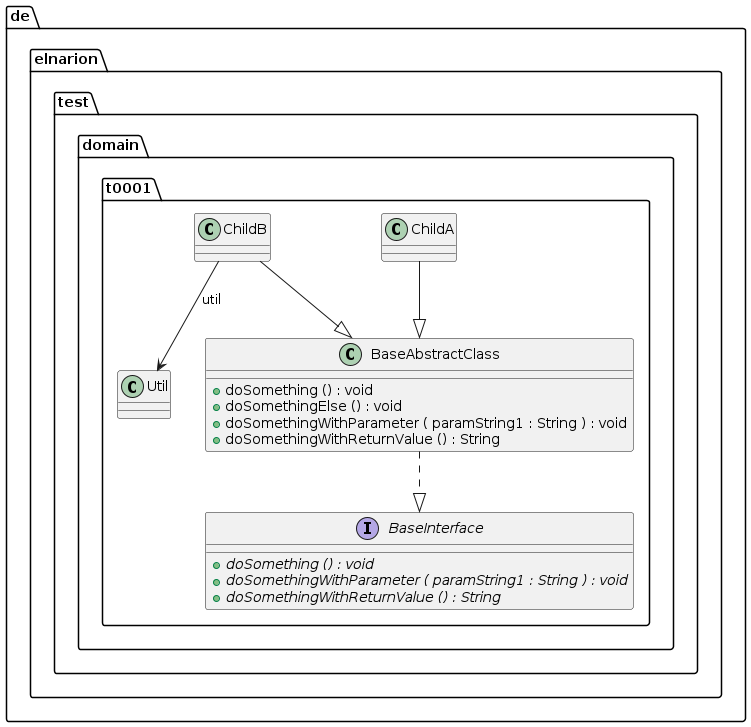hideClasses
Description
With this configuration toggle you can hide a class in the rendered diagram but it is still part of the generated diagram.
If you want to remove the class completely, you have to use a blacklist regular expression
Example
In the following example there are three dependencies in the maven dependency hierarchy which build the classpath for all further generation:
<dependencies>
<dependency>
<groupId>de.elnarion.util</groupId>
<artifactId>plantuml-generator-util</artifactId>
<version>@project.version@</version>
<classifier>tests</classifier>
<type>test-jar</type>
</dependency>
<dependency>
<groupId>commons-io</groupId>
<artifactId>commons-io</artifactId>
<version>2.16.1</version>
</dependency>
<dependency>
<groupId>javax.persistence</groupId>
<artifactId>javax.persistence-api</artifactId>
<version>2.2</version>
</dependency>
</dependencies>From this classpath all classes of the package "de.elnarion.test.domain.t0001", which are also used by the JUnit-tests of the PlantUML generator utility, should be generated as class diagram with the following plugin configuration:
<plugin>
<artifactId>plantuml-generator-maven-plugin</artifactId>
<groupId>de.elnarion.maven</groupId>
<version>@project.version@</version>
<executions>
<execution>
<id>generate-simple-diagram</id>
<goals>
<goal>generate</goal>
</goals>
<phase>generate-test-sources</phase>
<configuration>
<outputFilename>testdiagram1.txt</outputFilename>
<scanPackages>
<scanPackage>de.elnarion.test.domain.t0001</scanPackage>
</scanPackages>
<hideClasses>
<hideClasse>de.elnarion.test.domain.ChildB</hideClasse>
</hideClasses>
</configuration>
</execution>
</executions>
</plugin>but the class de.elnarion.test.domain.ChildB should be hidden in the rendered diagram. This configuration leads to this diagram:

and produces this PlantUML diagram text:
@startuml
class de.elnarion.test.domain.t0001.BaseAbstractClass {
{method} +doSomething () : void
{method} +doSomethingElse () : void
{method} +doSomethingWithParameter ( paramString1 : String ) : void
{method} +doSomethingWithReturnValue () : String
}
interface de.elnarion.test.domain.t0001.BaseInterface {
{method} {abstract} +doSomething () : void
{method} {abstract} +doSomethingWithParameter ( paramString1 : String ) : void
{method} {abstract} +doSomethingWithReturnValue () : String
}
class de.elnarion.test.domain.t0001.ChildA {
}
class de.elnarion.test.domain.t0001.ChildB {
}
class de.elnarion.test.domain.t0001.Util {
}
de.elnarion.test.domain.t0001.BaseAbstractClass ..|> de.elnarion.test.domain.t0001.BaseInterface
de.elnarion.test.domain.t0001.ChildA --|> de.elnarion.test.domain.t0001.BaseAbstractClass
de.elnarion.test.domain.t0001.ChildB --> de.elnarion.test.domain.t0001.Util : util
de.elnarion.test.domain.t0001.ChildB --|> de.elnarion.test.domain.t0001.BaseAbstractClass
hide de.elnarion.test.domain.ChildB
@enduml